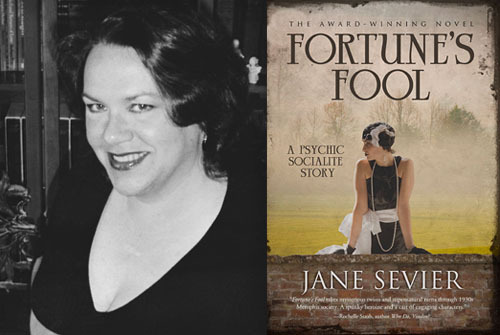Jane Sevier: A Perspective on Revision

Jane Sevier completed the first draft of Fortune's Fool during NaNoWriMo 2008. After revision and publication, the novel was a finalist in the Romance Writers Association's Golden Heart Awards. In this article (originally published on the Moody Muses blog), Jane discusses her post-NaNo process and how she built the book from the bones up. What lessons have you learned from your own revisions?
You made it through NaNoWriMo with your 50K or however many words. Then the holidays came along to distract you and let you recover a little while those words lay fallow for six weeks.
So, now what? If you're like me, you're itching to look back at what poured out of you in November. Or what you extracted with forceps and one foot braced against the desk. However those words arrived on the page, enough time has passed to give you a fresh perspective.
I spent this last NaNo working on the second book in my Psychic Socialite series that I launched in the fall with Fortune's Fool. Fool was my first NaNo win and great experience for what faces me now with the new book.
Fool started as just a premise. I knew the protagonist would be a 1930s Memphis socialite whose husband dies and leaves her penniless. She becomes a fortuneteller, only to discover that she has the true sight. I wanted the love interest to be a fake medium who bears a striking resemblance to Simon Baker of The Mentalist. And I knew Nell, my socialite, would be faced with providing for a household that included her mother-in-law and her cook and lifelong friend.
That was it. I didn't know the ending or even the mystery that Nell would have to unravel. Because Fool is the origin story for the series, I trusted that all would be revealed as I felt my way. I'm an organic writer who doesn't plot much, so I wasn't uncomfortable with that. It really helped that NaNo is the kind of hell-for-leather, don't-look-down ride that doesn't give you time to stop for doubt. And when the time came, the mystery showed up, as did the final scene.
After that NaNo, I put Fortune's Fool aside for several months while I worked on other projects. When I came back to it for the first read-through to get a feel for the story and what it needed, I was thrilled to find that the bones of a pretty good mystery were definitely there, although in a several places, the thigh bone was not necessarily connected to the hip bone. I had to figure out how to reassemble the skeleton so that it fit together in the best way for the story.
The next read-through, I looked for major scenes and turning points and compiled a scene list so I could see what I had and be able to move the pieces around. I also write screenplays, and studying their structure has helped me not plot exactly but organize what I've written after it's on the page. So, I made a chart dividing the story into "Act I," "Act II-Part I," "Midpoint," "Act II-Part II," and "Act III" based loosely on Blake Snyder's Save the Cat system. It would be some time and several reads before I decided those pieces were in the right place.
The next read was to be sure my characters were distinct, well-motivated individuals. Nell, Joseph Calendar, Miss Bess, and Hattie are so real to me that they practically wrote themselves. Having them as anchors made it easier to motivate the other cast members.
At first, I wanted a sort of über-villain who would be Moriarty to Nell's Sherlock throughout the series, but the scene and character-emotion reads told me that wasn't going to work with the way the story—and ultimately the series—were unfolding. So out with that idea. The mystery that showed up gave me several possibilities for the villain of this particular book. Then I just had to figure out why anyone would do such a thing.
I tend to write dialogue before anything else, and lots of it, so once the characters and structure were in place, I went through to be sure that I had action and description to help drive the story and evoke emotion without having a bunch of talking heads on every page.
Then, I read for style, remembering that Mark Twain said that the difference between the right word and almost the right word was the difference between lightening and lightening bug. And I love language so much that it's fun for me to play with words.
Along the way, I had wonderful beta readers go through the manuscript a couple of times. Their feedback gave me wonderful insights into what worked and what didn't. A final revision with all the pieces in mind, and I was ready to publish Fortune's Fool.
This all sounds a lot more organized than it was when I was actually revising Fortune's Fool. Having muddled through that, though, revising A Billy Sunday Kind of Love should be a piece of cake. Or at least less daunting. Right?
Chris Baty's Blog
- Chris Baty's profile
- 62 followers



